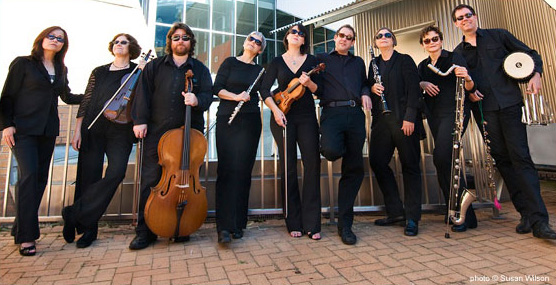Dinosaur Annex opens door to gifted Harvard composers
Student compositions lie in the margins of music history, for they show composers hard at work with techniques and musical languages that may or may not come to define a mature style. Beyond exercises, however, student works offer the chance for young composers to explore musical territory, a chance for talent to find its way.
Saturday night at Harvard University’s Paine Hall, in a concert sponsored by the Harvard Composers Association, five young composers had the opportunity to hear their pieces performed live by one of the city’s leading advocates for new music, the Dinosaur Annex Chamber Ensemble. The musicians of Dinosaur Annex approached each of the youthful works with the same level of commitment that they have brought to music by established masters.
The five works on the program exhibited a variety of compositional styles and an overall fine command of musical expression, a noteworthy achievement for composers at the beginnings of what one hopes will be promising careers.
The concert opened with a work marked for its simple tonal beauty. Stella Fiorenzoli’s the truth depends on a walk derives its title from a poem by Wallace Stevens, though its subject matter reflects the composer’s surroundings. While walking across the Boston Public Garden Lagoon in the dead of winter, Fiorenzoli, as she described in her program note, had an enlightening experience about the relationships between the earth, ice, and the human body.
The three movements of her work, a miniature sonata for violin and piano, reflect upon these relationships in music. The piece opens with flutters of violin melody that twist and spin over a stream of repeated notes in the piano. Sudden fortes and angular phrases punctuate the texture, the music a collage of disjointed phrases for a style similar to that of Nico Muhly. The brief second movement is characterized by motoric rhythms and a steady sense of propulsive energy. The third features elegant statements that are derived from the most basic material: a quiet progression of piano chords and violin phrases that seem to hang in space.
Pianist Randall Hodgkinson and violinist Charles Dimmick, playing with fine communication, gave the work a sensitive reading that made for charming listening. Some of the work’s most effective moments featured Hodgkinson playing with crisp, pearly tone while Dimmick floated glassy harmonics and silvery lines overhead.
The most colorful work of the evening came at concert’s end. Brandon Lincoln Snyder’s Viewing Lens, Magnetic Shards, Organisms, scored for clarinet, violin, cello, and piano, is, as the composer stated in his note, a musical depiction of changing perspectives. The material for this short, well-crafted work evolves from a soft clarinet melody, played by Katherine Matasy in feathery tones, which winds its way down from the instrument’s upper register. Violin, piano, and cello—played by Dimmick, Hodgkinson, and Rafael Popper-Keizer respectively—cover the phrase in a thin harmonic sheet.
The music central to the piece unfolds series of spacious intervals in the strings, out of which grow glissandi statements for each instrument. These statements dissipate into short ostinato motives, as if the composer were boiling the music down to its bare essentials. The piece ends as it began, with statements winding their way up the musical texture. Through it all, the Dinosaur Annex musicians, played with a delicate grace for a reading that was awash in soft colors.
The most contemplative piece heard Saturday evening was Auburn Lee’s The Swallow’s Tale for solo cello. The work involves little more than a wide, chromatic melody that meanders slowly through the cello’s lower and middle range. The lonely phrases break into burly passages of double stops high on the fingerboard and low growls on the instrument’s lowest string. Cellist Popper-Keizer played with a singing tone that brought out the work’s long arching line to fine effect.
The other work for solo cello heard Saturday evening was entirely different in character. Ben Wetherfield’s The Secret Society of Loss makes use of a full palette of instrumental color. Plucked notes on the fingerboard mesh with knocking sounds on the cello’s body, whistling harmonics, and scratchy sonorities that are created through rapid bow movements. The sound events that make up this interesting piece come in successive waves, which grow in intensity and agitation. Popper-Keizer played them all with bold statements that made a strong case for Wetherfield’s score.
Also colorful was Amir Bitran’s Vermilion, though the piece’s ambitious design at times felt gestural. This duet for a violin and cello is like several pieces rolled into one. Glassy harmonics played by Dimmick provided a thin accompaniment to stately phrases in Popper-Keizer’s cello. The instruments then came together in lush phrases for some of the piece’s most affecting moments. But those moments were brief, and the music soon broke into agitated statements, which evaporated into a series of high pitches and whistling harmonics. Here, too, Popper-Keizer and Dimmick played with expert communication and sensitivity to match the music’s frequent shifts in mood.
Dinosaur Annex will perform its annual Young Composers Concert 7:30 April 26 at the MIT Museum. dinosaurannex.org.
Posted in Performances




